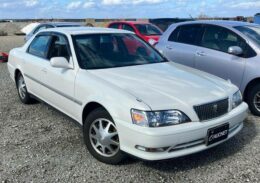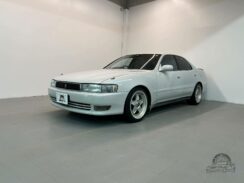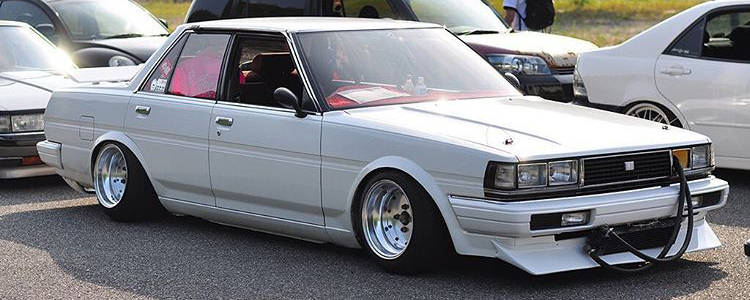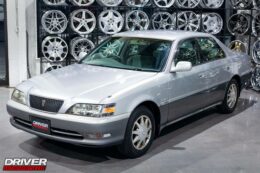
1998 Toyota Cresta Super Lucent GX100
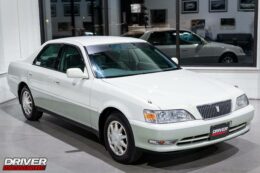
1997 Toyota Cresta Exceed 2.5 JZX100
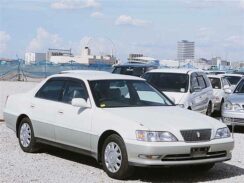
1997 Toyota Cresta
Toyota Cresta Buying Guide
The Toyota Cresta is a mid-luxury JDM Sedan made by Toyota from 1980 to 2001. It sits just below the Toyota Crown in terms of luxury, but most buyers prefer the Cresta over the Crown. Cresta is taken from the Italian word Cresta which simply means the top feathers on a bird’s head.
Italian rulers also wore crest crowns which signified Sovereignty but were less superior to the King’s Crown. Compared to the Toyota Mark II or Toyota Chaser, the Cresta sits above them regarding handling and performance despite sharing the same engine and transmission options.
The Cresta never sold that well in Japan is that Japanese laws had ridiculous tax regulations for long-wheelbase vehicles with engines with over 2.0 liters of displacement. Selling the first generation wasn’t that hard as most had 2.0-liter engines and a shorter wheelbase than other generations. But with time, higher displacement engines such as the 1G, 1JZ, and 2JZ came into production, and the wheelbase was increased.
Toyota started using these engines, forcing the Cresta to be exported more. Only a few models with 2.0-liter engines were sold in Japan. The Toyota Crown remains a Japan lenient model mainly sold in Japan and other RHD countries. At the same time, the US market gets the Camry and other Toyota Corolla models.
Being the sportiest in the Toyota Luxury sedan lineup, the Cresta was fitted with a supercharger in its third generation, X80. Toyota also introduced a two-tone colour paint to make it sportier and more appealing to younger buyers. Most customers who bought the Cresta were businessmen or businesswomen and corporates seeking luxury sedans.
You can turn a Toyota Cresta into a show car, drift car, or a daily driver if you can navigate around town in a “boat.” Most JDM sedans have a long wheelbase, and the Cresta is one of those with shorter wheelbases, but it’s still longer than most sedans. But this is what makes such cars unique as manufacturers don’t make them like they used to.
Pros and Cons
Pros
Great Interior Quality
Japanese manufacturers didn’t go wrong when they were making luxury sedans. At the time of production of the Toyota Cresta, there was a high demand for luxury sedans, so competition between manufacturers to provide the ultimate luxury sedan was high. Exterior luxury touches were not enough for the Toyota Cresta to stay in competition with vehicles such as the Nissan Cedric.
The first-gen Cresta, X50-X60, comes with a luxury fabric interior. If you want to buy one, you’ll find it with the original interior still looking fresh from the factory. It might be dirty but still better than most JDM classics’ interiors. Toyota began using leather seats in the second generation of production on high-spec models such as the Super Lucent G.
At the time of production, the Cresta was ahead of its time as it was equipped with powered seats, windows, doors, rearview mirrors, and rear window defrosters. There’s a chance that these might not work when you purchase the car, but nothing some wiring work and fuse replacement won’t fix.
Rear-Wheel-Drive
For a car that weighs over 3200 pounds, you’ll need it to be rear-wheel-drive or all-wheel drive. The Toyota Cresta was made as a front-engine rear-wheel-drive car, with some models being equipped with an LSD. Surprisingly in 1993, Toyota made AWD optional for the X90 Cresta Touring spec, but these are rare and expensive. An X90 Cresta Touring will cost 2 or 3 times more than any Cresta, depending on its condition.
Being rear-wheel-drive makes the Cresta an excellent drift car budget build, as you can easily find one listed for around $6,000. If you find one with an LSD, you are in luck, as you won’t have to install one or weld the rear diff.
The Cresta also handles well because it’s RWD. You don’t have to worry about loss of traction when cruising on mountain roads and understeer when driving in town. Traction loss is also minimized by the massive weight pushing down on the rear wheels.
Highly Tunable Engine Options
The Toyota Cresta comes with Toyota’s most tunable engines, the 1JZ, 2JZ, and the 1G engines. Other engines, including a 2.4-liter turbodiesel, were used in base spec models that you can rarely find. Besides, most buyers and even you will probably go for one with a 1G or JZ engine when buying a Cresta.
The 1G engines were used throughout Cresta’s production. In the first-gen and second-gen Cresta, you get the 1G-EU and the 2.0-liter DOHC 1G-GEU. The 1G-EU made around 110 horsepower at the time of production, while the 1G-GEU made an extra 40 horsepower.
Due to the age of these engines, you can only squeeze around 250 horsepower with stock internals. Anything above that, you’ll be risking a cracked engine block or broken piston rods. However, suppose you decide to rebuild the engine with new forged internals and upgrade the turbo and a new exhaust system. In that case, you’ll easily get over 400 horsepower.
Other 1G engine variants used include the 1G-GZE, 1G-GE, and 1GFE. These engines can handle a similar power output as the 1G and 1G-GEU, except for the 1G-GE and 1G-GTE, which are considered the most tunable 1G engines. You can easily make 400 horsepower with stock internals if you get your hands on either.
JZ engine variants available in the Cresta include; 1JZ-GE, 2JZ-GE, and the 1JZ-GTE (twin-turbocharged), the same engine used in the MK3 Toyota Supra. With a 1JZ engine, you can easily make 500 horsepower without worrying about its durability, provided that it’s in good condition. If the engine shows signs of failure, consider an engine rebuild before tuning and upgrading supporting components.
The 2JZ is the best Toyota engine ever made but is only used in a few X90 and X100 Cresta units. However, finding a Cresta with a 2JZ engine is almost impossible since people will buy a Cresta only to remove the engine and use it on another build. A well-maintained 2JZ will easily make 600-700 horsepower. Still, you’ll need to put more work, mods, and money into the naturally aspirated 2JZ-GE to reach such figures.
Read more on 1JZ and 2JZ engines here
Fun To Drive
When stock, a Toyota Cresta might not be quick as you expect, even with a 2JZ engine. But to start with, it wasn’t built to be fast. It was made to be luxurious and comfortable, and the engine options were only put there to handle its massive weight. Better than the fuel-gobbling UZ V8 engine.
The Toyota Cresta is a car you take out on a Sunday evening cruise on the highway and backroads. Enjoy that straight piped JZ engine music as you make memories with your friends or family. At times like these, one could easily pick a Cresta over a Supra as it offers what the Supra cannot, three more extra seats for whoever you decide to take on a drive with.
Cons
Too Heavy For a Drift Car
The Toyota Cresta ticks all drift car requirements except the weight requirements. Most drifting pros suggest that a drift car should weigh around 2000 to 2900 pounds if you want to hold a drift for longer or when drifting in tandem and you don’t want to lag behind your crew.
When stock, a Cresta weighs around 3200 pounds. Suppose you decide to add modifications such as a roll cage, chassis bracing, and suspension upgrades. In that case, you are increasing the car’s weight and needing to remove unnecessary weight.
You can do this by stripping the interior, which will shed a few hundred pounds. If this doesn’t cut, move on to the body panels, doors, hood, and trunk. Since all these are made of heavy metal, replace them with reinforced plastic which you can do away with later or keep if not damaged. Besides, you wouldn’t want to damage the factory body panels, doors, trunk, and hood.
Poor Gas Mileage
The JZ and 1G engines used in the Toyota Cresta might not gobble up as much fuel as the UZ and other V8 engines used in the Crown and Chaser. However, they still have poor fuel consumption, especially when fiddled around.
This is mainly due to the weight. Well, most of Cresta’s issues are weight-related. When stock, you’ll get around 20mpg on an NA JZ engine which reduces to around 18mpg if the engine is turbocharged. If you decide to modify the engine, one of the factors that change is the combustion rate. More fuel gets combusted after mixing with air, which increases fuel consumption.
Most come with an Automatic Transmission
Suppose you are searching for a Toyota Cresta with a manual transmission. In that case, you’ll have to wait longer or buy an automatic. This is a shared disadvantage with luxury JDM sedans from all manufacturers, including Nissan and Honda.
The first-gen Cresta, X50-X60, was only sold with a 4-speed automatic transmission. At the production time, manual transmission vehicles had a better fuel consumption. Still, automatic transmission vehicles were easier to drive and maintain.
Most drivers preferred cars with an automatic transmission, especially in vehicles as heavy as the Toyota Cresta. It’s not like they would compete in the Midnight Club against sports cars like the Nissan Skyline or Toyota Supra. It made more sense to install a manual transmission in a Toyota Supra or Celica rather than a Toyota Cresta or Crown.
If you want a Cresta with a manual transmission, look for one with the turbocharged 1JZ-GTE or the supercharged 1G-GZE.
Common Issues
Failure To Start
There are a couple of reasons why your engine will not start. The 1G and JZ engines have a similar structure and share the same issues as you would expect. If the motor is not starting, you should check the spark plugs, ignition coils, and VVT solenoid, which are some of the faultiest components that might lead to so.
Depending on the driver’s driving habit, the spark plugs are replaced between 30,000 and 90,000 miles on most engines. But on the Cresta, you recommend replacing the spark plugs every 10,000 to 15,000 miles. This is because oil and carbonated soot accumulate on the sparkplugs quicker on the 1G and JZ engines.
If the spark plugs check out, check the ignition coil, which delivers voltage to the spark plugs. One of the easiest ways to know if you have a faulty ignition coil is if the engine misfires or you have a decreasing gas mileage if the spark plugs are in good condition. You should replace the ignition coil if you also notice a hard start. Besides, if the car still has its original alternator or there’s no sign of it being replaced, replace it before your Cresta stalls on you.
The VVT (Variable Valve Timing) solenoid is responsible for the opening and closing of the oil intake and exhaust valves. Rarely will the VVT solenoid become faulty, but with a 25-year-old engine, expect such issues to occur. This should be an easy fix as it is mainly clogged by sludge from the old oil, and all you have to do is clean it during an oil change.
However, if the issue persists, consider replacing the VVT solenoid as the screen is too worn out. While at it, you can also replace the oil intake valve or clean it during an oil change. If the VVT solenoid is clogged, you’ll notice high-temperature readings, poor fuel consumption, and misfires.
Oxygen Sensor Failure (High Fuel Consumption)
The oxygen sensor on 1G and JZ engines is known to fail at around 30,000 miles or less if the car is in constant use or has faulty components which lead to its failure. It’s responsible for measuring the amount of oxygen in the exhaust gases. It sends this data to the ECU, which determines the amount of oxygen to fuel ratio entering the combustion chamber.
Suppose the oxygen sensor transmits incorrect data to the ECU. The air-to-fuel ratio will be inefficient, leading to stalling, misfires, and a rough running engine. Suppose the data is translated that more air is needed. In that case, excess air and fuel will be injected into the combustion chamber, decreasing gas mileage.
The oxygen sensor is mainly contaminated by fumes from the exhaust gases and coolant and oil from a leaky head gasket or cracked cylinder walls near the oxygen sensor. Regardless of how much you might want to do it, you cannot clean an oxygen air sensor as you risk it malfunctioning. The best solution is to replace.
High Oil Consumption
High oil consumption is expected in 1G and JZ engines, especially in the 1G-FE, 1JZ-GTE, and 2JZ. But when oil consumption becomes too much, you lose motivation to take your Cresta out on a cruise or to a drift track as you could be risking overheating.
Since these engines are old, you can reduce oil consumption by replacing the valve stem seals and piston rings, decarbonizing the engine, and rebuilding the engine. Suppose the car has high mileage or shows constant use due to worn-out engine components. In that case, you should consider replacing the valve stem seals and piston rings while also rebuilding the engine at the same time.
If the valve seal is broken or the piston rings are worn, oil leaks into the combustion chamber, causing an increase in fuel consumption. You can replace these separately but since rebuilding the engine is also an option, you can replace them when rebuilding it.
Engine decarbonization is whereby all carbon buildup in the engine is removed. When carbon deposits build up on moving parts, it increases friction, thus increasing oil consumption. Decarbonization might not help as much as other methods, but it’s still worth it. An injector cleaning or an overnight soak with a recommended decarbonization formula can be done.
By doing all these on your Cresta, you also prevent oil leakages, and you should also replace the oil sensor while at it.
Rough Idle
Due to old age, the fuel injectors and air filter on a high-mileage Toyota Cresta will need to be cleaned out or replaced depending on their condition. If the fuel injectors are clogged, they will not inject the right amount of fuel, which applies to the air filter. A clogged air filter will prevent sufficient air from getting into the engine, causing a rough idle or loss of power due to inefficient combustion.
You can clean the fuel injectors and the air filter but replacing them is the best option, especially if they have been on the car for a long time. If you plan on increasing the engine’s power output, you will upgrade the fuel injectors.
To avoid such issues in the future, you can have a compression test done on your engine. This ensures no wear on the pistons, piston rings, cylinder strokes, and valves. If these are worn out, it could also lead to all the above issues.
Average Prices
The Toyota Cresta is quite affordable even for beginners and teenagers for a car you can get with a JZ engine. It also makes the perfect budget drift build as it’s RWD and lighter than some of its alternatives. Prices start at approximately $4,000, which is not bad for a car with a 6-cylinder engine, be it a 1G-EU or a JJZ-GTE.
If you are looking for a high spec model, low mileage, or souped-up Toyota Cresta, expect to pay more than the price of a standard one. These usually start at around $7,000 to $20,000, with the models with the 1JZ or 2JZ engines being the most expensive. But you are getting a Supra with 4 doors at a bargain.
Comparable Alternatives
- Toyota Chaser (Read our Buying Guide)
- Toyota Mark II (Read our Buying Guide)
- Toyota Celsior (Read our Buying Guide)
- Nissan Skyline Sedan (Read the Complete Skyline Buying Guide)
- Nissan Cima
- Nissan Cedric (Read our Buying Guide)
Models and Specifications
1980-1984 Toyota Cresta (X50, X60)
The first-gen Cresta was unveiled in 1980, and it was more like a short-wheelbase version of the Toyota Crown, which had entered its sixth generation (S110) in 1979. At the time of production, the Crown had a 2.0-liter engine, 2.4-liter engine, 2.5-liter engine, and a 2.7-liter engine. Only models with a 2.0-liter engine were commonly sold in Japan, but long-wheel-base cars had to comply with strict tax laws.
When the Toyota Cresta went on sale in late 1980, it only had a 2.0-liter engine in different variants, enabling Toyota to sell more units than the Toyota Crown. You get the X50/X60 Cresta with a 2.0-liter M-EU engine, 2.0-liter 1G-EU, or 2.0-liter 1G-GEU driving the rear wheels via a 4-speed automatic transmission.
Luxury trims such as the Super Touring, Super Lucent, Custom, Super Custom, and Super Deluxe were introduced in the second year of production. Significant differences with the base Cresta are powered mirrors, doors, windows, and climate adjustable AC. The seats are also wrapped with better fabric, and the floor mats are also made from quality material.
On the Exterior, you get chrome surrounding the headlights, rearview mirrors, and taillights instead of plastic on the base-spec models. You also get wheel caps or alloy wheels which are not standard on most cars made in the 1980s.
But Toyota was not only making a luxury sedan for the Japanese market to compete with others, such as the Nissan Laurel, they were also making one that could sell worldwide. This led to the creation of the Lexus LS lineup by Lexus, which is Toyota’s luxury and performance unit.
1984-1988 Toyota Cresta (X70)
The first-generation Cresta platform was discontinued. The X70 Cresta uses a platform similar to the one used on the X70 Mark II. As a result, the second-gen Cresta has more extended body panels and four windows on each side instead of the two windows on the first-gen Cresta.
You might probably wonder why there are four windows, yet you can only see two on each side. The front door quarter windows near the side mirrors and the rear door quarter windows near the rear windshield are counted as windows. The front fender-mounted rearview mirrors were removed, and in the second-gen Cresta, they sit just under the front door quarter windows.
The 1G-EU and the 1G-GEU 2.0-liter engines were still used, and a new 2.0-liter turbocharged M-TEU was introduced for the second-gen Cresta. You can get an X70 Cresta with a 2.0-liter twin-turbocharged 1G-GTE if you are lucky. Like the X50/X60 Cresta, the X70 Cresta is also rear-wheel drive and only comes with a 4-speed automatic transmission.
You can also get the X70 Cresta with two 4-cylinder diesel engines. A 2.4-liter 2L (Na) and a 2.4-liter 2L-T (turbodiesel) engine, you can do so in a diesel Cresta if you love rolling coal.
Luxury trims had similar badging and features as the X50/X60 Cresta, but there was a twist in the Super Touring Cresta X70. It was equipped with front bucket seats at production, and the rear seats were bolstered. The twin-turbo 1G-GTE only made 185 to 230 horsepower. Still, this was enough power to send the driver and passengers sideways when cornering at the production time.
1988-1992 Toyota Cresta (X80)
There’s not much difference between the X70 and X80 Cresta except that the X80 Cresta features straightened-out body lines. The Chaser was originally a Mark II model. Still, Toyota later produced it independently alongside the Toyota Cressida and Toyota Comfort.
You get the X80 Cresta with several variants of the 1G engine series, including a supercharged 1G-GZE which you can get in the Mark II, Cressida, and Chaser. Despite being supercharged, the 1G-GZE made 170 horsepower at the production time. If you are looking for a reliable powerhouse, the twin-turbocharged 1G-GTE is a better option.
Toyota installed a 1JZ-GE and a twin-turbocharged 1JZ-GTE in the X80 Chaser. When it was installed in the X80 Chaser, it made around 230 horsepower which was increased to 300 horsepower in the Cresta X100, advertised as 280 horsepower due to the Gentleman’s Agreement of 1988. The 1JZ-GTE was installed in the Cresta GT and Avante, while the 1G-GZE in the Super Lucent G.
A new 5-speed manual transmission was also introduced in the Cresta, mainly installed in the Super Lucent G and GT trims.
In 1987 when Toyota was Celebrating its 50th Anniversary, the Cresta was one of the few models that received a facelift and special Anniversary touches. Anniversary models have a golden or silver 50th Anniversary badge and stitching on the seats. Most have the 1G-GTE, which made around 210 horsepower at production.
1992-1996 Toyota Cresta (X90)
The X90 Toyota Cresta went into production in late 1992. Still, it was no longer a compact class car due to the new extended chassis. Toyota aimed more for other markets outside Japan and for buyers in Japan who wanted a compact class car; there was the Toyota Camry and other models in the Toyota Corolla lineup.
Now that the Cresta was not in the Compact Class, fewer units were produced with a 2.0-liter engine. Only the 1G-FE was used in the X90 Cresta. A new 4-cylinder 4S-FE used in the Toyota Corolla lineup was also available for Japanese buyers who wanted to avoid high road taxes. In Japan, vehicles with lower displacement engines pay lower road taxes.
More JZ engines were used in the X90 Cresta than in its predecessors. If you want a Cresta with a JZ engine, you’ll want a JZX90 Cresta.
The luxury sedan market in Japan was so competitive that Toyota had to up their game for the Japanese market and the international market with competitors such as Mercedes, Audi, and BMW lurking. The X90 Cresta was now equipped with ABS, an LSD, leather seats and steering with heating and cooling functionality.
Such features were optional on high spec models such as the Tourer and Super Lucent trims. All Tourer trims have the JZ engine. The Tourer S has the 2.5-liter 1JZ, while the Tourer V has a twin-turbocharged 2.5-liter 1JZ-GTE with an optional 5-speed manual transmission. All base spec models and the Tourer S have a 4-speed manual transmission.
The 2JZ was installed on the Grande and the Grande G with a 4-speed manual transmission. Luxury sedans in Japan slowly became a favourite among drifters. RWD sports cars such as the Skyline and Supra were expensive to build into drift cars.
1996-2001 Toyota Cresta (X100)
This is the last generation of the Toyota Cresta produced between 1996-2001. Except for the 2.0-liter 1G-FE, all engines used in the Toyota Cresta have over 2.0-liters of displacement. In Japan, the X100 Cresta was sold either with the 2.0-liter 1G-FE or the 2.4-liter turbodiesel (2l-LTE) used in the GL trim.
Other engines include the 2.5-liter 1JZ-GE, 3.0-liter 2JZ-GE, and the turbocharged 1JZ-GTE, which was tuned up to over 300 horsepower but with a single turbo, unlike its predecessor. However, on paper, it was indicated 280 horsepower due to the Gentlemen’s Agreement.
Base spec models, Grande, mainly have the 1G-FE mated to either a 4-speed automatic or 5-speed manual transmission with an optional LSD, traction control, and ABS. Powered mirrors, rearview mirrors, and seats were standard on the base spec model.
The Tourer V has the turbocharged 1JZ-GTE, while the Tourer S has the 1JZ-GE. The 2JZ is available in the Grande and Grande G. You can also get the Grande G with the 1JZGE. On high spec models, buyers could either choose a 5-speed manual transmission or a 4-speed manual, except the Grande G, which was only sold with a 4-speed automatic transmission.
FAQ
The Toyota Cresta excels in whatever you decide to do. It makes the perfect car for a drift car build, show car build, and even a daily-driven luxury sedan. Finding a parking space might be difficult due to the large wheelbase and tight parking spots in towns and cities. But if you have a dedicated parking area, you can drive it to school or work.
Fuel consumption might be a bit on the higher side. Still, everything else regarding maintenance on the Cresta is easy, perfect, simple, and affordable. You simply can’t go wrong with classic JDM sedans, especially if it’s a Toyota.
Yes. But you can only get the naturally aspirated 2JZ-GE in a Toyota Cresta.
Yes. You can turn the Cresta into a drift missile, show car, or daily driver. JDM sedans have broad aftermarket support. If a component becomes too hard to find, other Toyota sedans, such as the Mark II, Cressida, and Chaser, from which you can source parts. Aftermarket parts for these cars are also compatible with every one of them.
If you get one with a 4-cylinder 4S-FE or an early production 1G engine, you might consider engine swapping with a UZ or any other V8. However, fitting a Toyota engine is more manageable than any other V8 as no major fabrications and parts are required. But the engine bay size should not worry you.
Not really. But these cars share the same engines and transmissions. The Chaser and Cressida were first produced as Mark II trims and later independently made.
How to Import a Toyota Cresta
Read our Ultimate Guide on How to Import a Car from Japan.
